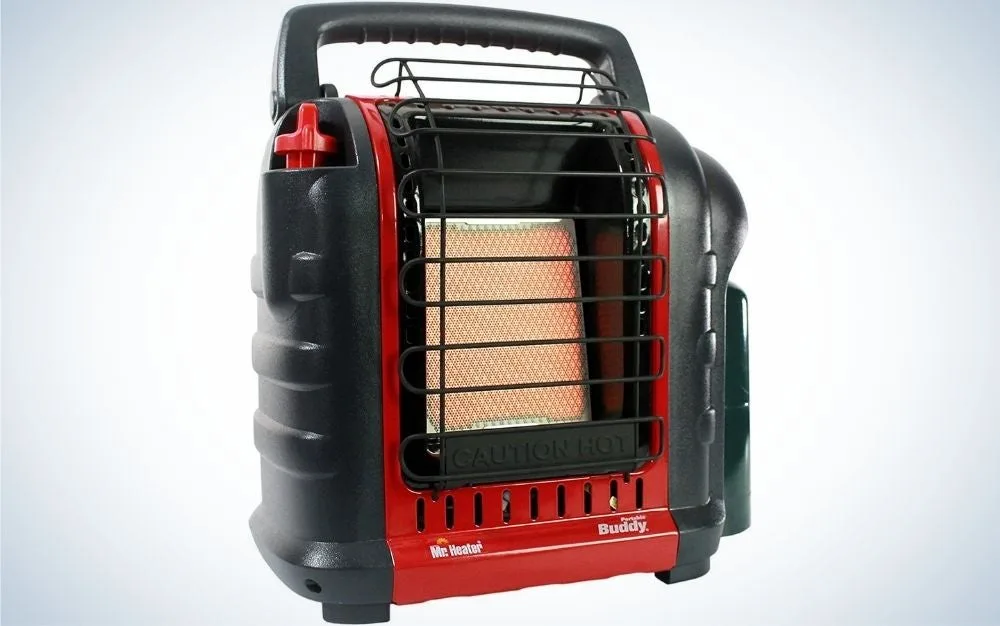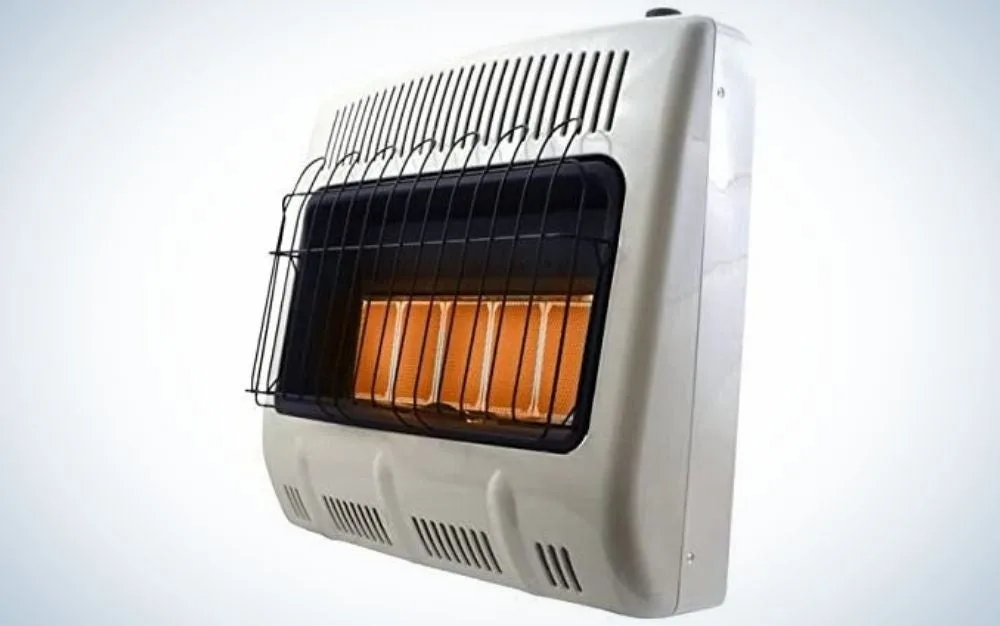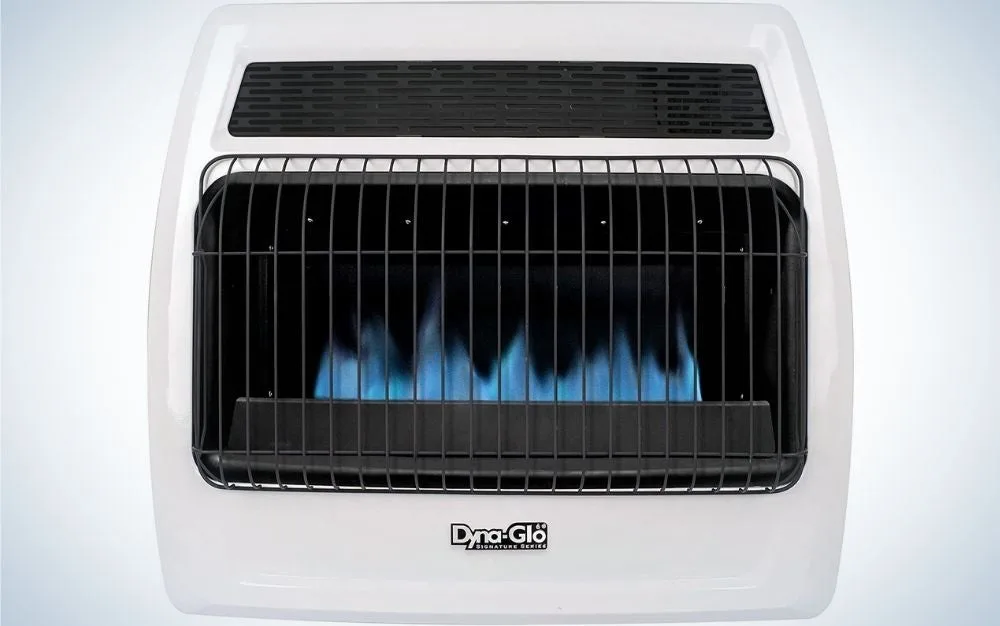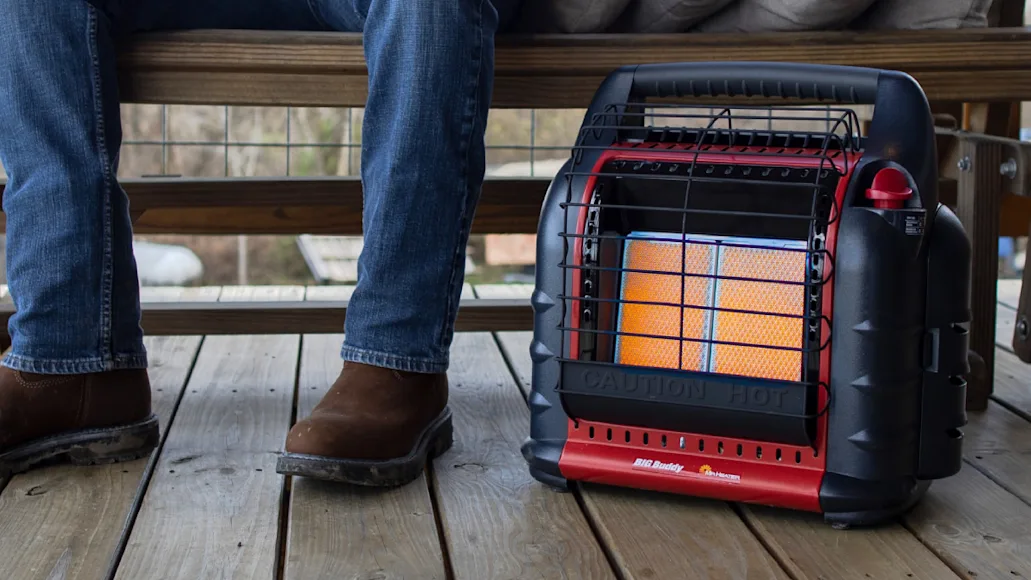_We may earn revenue from the products available on this page and participate in affiliate programs. Learn more ›
_
Best Overall

Mr. Heater 4,000-9000 BTU Portable Buddy
LEARN MORE
Summary
Weighs only 9 pounds and will heat up to 225 square feet.
Best for Small Cabins

Mr. Heater Vent-Free 30,000 BTU Radiant Propane Heater
LEARN MORE
Summary
Can be wall mounted and has dual oxygen depletion sensors.
Best Patio Heater

AZ Patio Heaters Hiland Pyramid Propane Heater
LEARN MORE
Summary
Weighs 2 pounds and attaches to a 1-pound canister.
Propane heaters keep you warm, whether you’re in the woods or the woodshop. By connecting to a propane fuel source––be it a portable one-pound canister or a 100-pound tank––propane heaters emit warmth by burning the gas and projecting the resulting heat. Some units rely on metal reflectors, while others produce radiant heat that travels through the air like the sun’s rays. Fans help circulate the warmth in forced-air units. They also serve as emergency equipment
in the event of a power outage.
Propane heaters can be small, portable burners that sit atop camping canisters, or they can be larger standup units that create a warm ambiance on your patio. Many people prefer them to kerosene heaters
, which are cheaper to operate but require use and storage of kerosene. Propane heaters burn very efficiently, but even if they’re approved for indoor or outdoor use, they can emit carbon monoxide
if there’s an incomplete burn caused by a lack of oxygen in a space that isn’t ventilated. To keep you safe and warm, we’ve rounded up the best propane heaters for every situation below.
Best Overall: Mr. Heater 4,000-9000 BTU Portable Buddy
Best Indoor: Dyna-Glo 30,000 BTU Liquid Propane Blue Flame Heater
Best Small: Mr. Heater Vent-Free 30,000 BTU Radiant Propane Heater
Best Outdoor: AZ Patio Heaters Hiland Pyramid Propane Heater
Best Portable: Camco Olympian Wave Propane Heater
How We Picked the Best Propane Heaters
As outdoorsmen and women, we often find ourselves using heaters to stay warm. Whether on a winter ski trip to a remote cabin or hanging on the patio during the cool fall months—staying warm is not only critical for safety, but also for enjoyment. After spending a lot of time outside and around heaters we’ve come to focus on some key components when selecting a quality propane heater. We based our picks on the following criteria:
• BTUs: How powerful is the heater?• Rate of fuel consumption: How fast does the heater burn fuel?• Square footage of space the propane heater can warm: What size area can the heater warm?• Size: How large is the heater and how much room do you need to use it?• Weight: How heavy is the heater and is it portable?• Mounting options: Can the heater be mounted on a wall or accessory?• Safety precautions: Does the heater have automatic shutoffs that can be triggered in response to the heater tipping, or low oxygen levels?
Best Propane Heaters: Reviews & Recommendations
Best Overall: Mr. Heater 4,000-9000 BTU Portable Buddy
Best Portable Propane Heater

Specs
Weight: 9 pounds
Product Dimensions: 7.7-inch (L) x 15-inch (H) x 13.4-inch (W)
BTUs: Up to 9,000
Pros
Automatic shutoff if unit tips, gets too hot, detects low oxygen, or pilot light goes out
Easy-grip handle
Safe for indoor use
Works with one-pound propane canister
Cons
May shut off above 7,000 feet
Reviewers report very sensitive sensors
You don’t need to carry a pistol to pack heat. This lightweight portable propane heater will work for the campsite, garage, or small cabin. Two settings pump out radiant heat at either 4,000 or 9,000 BTUs, capable of warming a space up to 225 square feet. Tilt and oxygen sensors help make this safe for indoor use. And a common 1-pound camping canister is all the propane you need. The portable propane heater will burn for 2.5 hours on full blast or 5.5 hours on the lower setting before you have to change tanks.
Best Indoor: Dyna-Glo 30,000 BTU Liquid Propane Blue Flame Heater
Best Indoor

Specs
Weight: 27.6 pounds
Product Dimensions: 28.07″ W x 10.51″ D x 24.09″ H
Heat Settings: 5
Pros
Easy to install
Circulates heat efficiently
Oxygen depletion sensor ensures safe use
Adjustable temperature control
Cons
Requires 100-pound propane tank
By convecting heat, which uses the density difference between hot and cold air to produce a constant flow, this Dyna-Glo propane heater offers an efficient output of 30,000 BTUs, and is capable of heating a 1,000-square-foot room. The vent-free system is made for indoor use, and the temperature dial lets you easily adjust the heat. Mount it to your wall, or stand it on legs (the leg mounts are sold separately). You can also connect this propane heater to your home’s natural gas line.
Best Small: Mr. Heater Vent-Free 30,000 BTU Radiant Propane Heater
Best Small

Specs
Weight: 39 pounds
Product Dimensions: 13.25-inch (L) x 31-inch (W) x 28.37-inch (H)
Fuel Consumption: 1.389 pounds/hour
Pros
Safety sensors
Leg and wall mounts included
Runs on a common 20-pound propane tank
Cons
Won’t operate above 4,500 feet
Safety sensors can seem overly sensitive
Producing radiant heat, this vent-free propane heater can warm up to 1,000 feet of space––in bigger spaces it’s designed to supplement another heat source. Wall or stand mounting gives you the option of portability, and the turn knob lets you dial up the right level of warmth. Perhaps most importantly, oxygen depletion sensors give you peace of mind that the heater is operating safely.
Best Outdoor: AZ Patio Heaters Hiland Pyramid Propane Heater
Best Outdoor

Specs
Weight: 65 pounds
Height: 91 inches
Output: 40,000 BTUs
Pros
360 degrees of heat
Uses standard 20-pound propane tank
Temperature and tilt safety measures
Cons
Less than 10 hours of usage per tank
Costs nearly $500
A patio heater is as much about the ambiance as it is about warmth, and this propane unit provides plenty of both. This pyramid propane heater can pump out 40,000 BTUs of heat, which means it’s capable of providing 360 degrees of warmth around a 10-square-foot area. The 20-pound tank tucks away nicely in the bottom compartment, which is covered in a hammered silver finish. Sensors will automatically shut the heater off if it starts to fail or gets too warm. And wheels allow you to easily move the propane heater from one location to another.
Best Portable: Camco Olympian Wave Propane Heater
Best Portable

Specs
Weight: 1.52 pounds
Product Dimensions: 14.5-inch (L) x 11.75-inch (W) x 4.88-inch (H)
BTUs: Up to 3,000
Pros
Works at elevation
Lightweight
Piezo automatic starter
No fan means no noise
Cons
Only heats up to 100 square feet
Must be used in vented or open areas
Requiring no open flame and producing only water and CO2 as waste, this propane catalytic heater works in any vented environment––including above 7,000 feet. There’s no fan to blow the heat, which limits the warmable space to 100 square feet. This also means the high-altitude propane heater operates very quietly. The automatic push-button ignition is made to last 20,000 starts, and an automatic shutoff will be triggered if the unit detects a leak, making it both easy and safe to use.
What to Consider When Choosing a Propane Heater
Type
Propane heaters can be small enough to fit into the cupholder of a golf cart or sit atop a picnic table, or they can be larger permanent units that mount onto a wall. Patio heaters stand tall and give off heat in every direction, while portable outdoor heaters are ideal for boats or hunting blinds. Some propane heaters have forced-air systems that use fans to blast hot air produced by burning propane, while radiant propane heaters have elements that give off heat much like the sun and use reflectors to help guide the warmth.
Convection heaters circulate air through heating elements, taking advantage of the density differences between hot and cold air to keep the heater constantly energized. Convection heaters are typically the most energy efficient, but they can also be more expensive. Many patio units or portable propane heaters use radiant heat, warming you much like the flames of a campfire.
Energy Output
A propane heater’s energy output is measured in British Thermal Units (BTUs), and propane heaters can span from roughly 3,000 BTUs to more than 40,000. Generally speaking, the higher the BTU count, the more warmth a propane heater is capable of producing, and thus the larger the area that it can heat. However, powerful patio heaters have tens of thousands of BTUs, but they are not safe for indoor use, so the area of warmth is diminished as the heat dissipates in the open air.
Propane Tank Size
Propane heaters are not one-tank-size-fits-all. Some units require connections to large 100-gallon tanks, while smaller portable propane heaters can attach to 1-pound canisters. Many of the best propane heaters can connect to a common 20-pound gas-grill propane tank.
Beyond the size of the fuel tank, it’s important to pay attention to a propane heater’s burn rate. Some propane heaters will drain a 20-pound tank in less than 10 hours, while others can stretch that by several hours. If you need more sustained heat rather than more powerful heat, the latter option may be right for you.
Ignition System
Most of the best propane heaters feature automatic electric starting systems that allow you to press a button to ignite the heating element. But some models require manual ignition. Automatic Piezo starters work by placing a crystal between two metal plates. When you push the button, you move the crystal, allowing the charged plates to spark. Such systems are designed to last for more than 20,000 starts. Manual ignition will work as long as you have matches or a lighter, and propane in the tank.
Safety Features
While propane is an efficient source of energy, burning it can produce potentially dangerous carbon monoxide if combustion is incomplete due to low oxygen levels or a malfunctioning unit. (The state of California bans indoor vent-free units). But the best propane heaters are equipped with oxygen depletion systems that will automatically turn the heater off when nearby oxygen levels are too low. Other propane heaters will turn off if a leak is detected, preventing you from flooding an enclosed space with propane. Other units have tilt sensors that shut off before the heater falls. Such safety measures are critical if you plan to heat an indoor space, though some sensors can be too sensitive for some user’s tastes.
FAQs
Q: How much do propane heaters cost?
Propane heaters cost anywhere from $50 for portable units to more than $500 for standup heaters suited for the patio.
Q: What propane heaters are safe to use indoors?
Propane heaters that are vent-free are safe to use indoors. Such units pull oxygen from the room and emit heat and carbon dioxide. This heating process is extremely efficient, but it can be dangerous if there is not an adequate supply of oxygen in the area. That results in incomplete burning, which results in carbon monoxide emissions. Many of the best propane heaters feature oxygen depletion sensors that will shut the unit off as soon as oxygen levels in the room are too low, or if the pilot light goes out. Properly installed carbon monoxide detectors in your home can also help keep you safe.
Q: Do propane heaters work?
Propane heaters absolutely work. Ignition, either through an electric starter or a match, reacts with flowing propane gas to produce radiant or blowable heat. The best propane heaters can warm outdoor spaces or can even be used to heat homes of more than 1,000 square feet.
Q: Does propane get too old to use?
No, propane does not get too old to use. As long as your tank is completely air-tight, propane fuel has no expiration date. Tanks, however, may be compromised after more than a decade. Look for signs of deterioration such as rust or corrosion.
Best Propane Heaters: Final Thoughts
Best Overall: Mr. Heater 4,000-9000 BTU Portable Buddy
Best Indoor: Dyna-Glo 30,000 BTU Liquid Propane Blue Flame Heater
Best Small: Mr. Heater Vent-Free 30,000 BTU Radiant Propane Heater
Best Outdoor: AZ Patio Heaters Hiland Pyramid Propane Heater
Best Portable: Camco Olympian Wave Propane Heater
The best propane heaters will keep you warm—or warm enough—so you can stay comfortable. When putting together this list of propane heaters we wanted to break down our choices depending on the situation and use. The six different categories above cover a wide range of situations from the
Hiland Pyramid Propane Heater for the patio to theMr. Heater Vent-Free 30,000 BTU for small cabins. Whichever choice you decide to go with, make sure to follow the instructions and only use your heater in areas that are safe to do so.
Why Trust Us
For more than 125 years, Field & Stream has been providing readers with honest and authentic coverage of outdoor gear. Our writers and editors eat, sleep, and breathe the outdoors, and that passion comes through in our product reviews. You can count on F&S to keep you up to date on the best new gear. And when we write about a product—whether it’s a bass lure or a backpack—we cover the good and the bad, so you know exactly what to expect before you decide to make a purchase.





